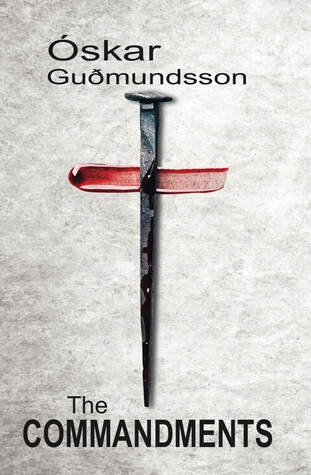
The Commandments by Óskar Guðmundsson
Translated by Quentin Bates | Published by Corylus Books

I’ve been a Nordic Noir fan since the early 1990s, when I read “Smilla’s Sense of Snow”, by Peter Høeg, and the Martin Beck mystery series by Maj Sjöwall and Per Wahlöö. However, it wasn’t until the success of the Lisbeth Salander “Dragon Tattoo” trilogy by Stieg Larsson (2005) that mysteries from Sweden, Norway, Iceland, Denmark and Finland began to be widely translated and published in the US. What draws me to the genre? I think it’s for the same reason I have such an unquenchable passion for polar history and exploration: Harsh surroundings and the knowledge that environment is as important as plot. Spare, beautiful prose. Words like forbidding, suspenseful, threatening, cold, bleak. Most of all, the character development that continues from book to book, as many of them are series.
So, every time I come across a new Nordic mystery I know I’ll be reading it. When Ewa Sherman reached out to ask if I would like to review Óskar Guðmundsson’s “The Commandments” I jumped at the chance and I was not disappointed; it is a welcome addition to the genre. Many of these books feature strong, intelligent and capable women and the protagonist Salka Steinsdóttir is no exception.

Author Óskar Guðmundsson
The book begins with a chapter set in 1995, and offers disturbing hints of what’s to come:
Once they had made plain their heathen tendencies, Helgi
had asked the pair of them to stay behind after the lesson.
That was when it had all started.
First sweets. Then money. Finally, there had been booze.
Everything changed.
The next chapter resumes in 2014. Salka Steinsdóttir is a former police officer who we meet fly fishing in the Lax River in northern Iceland. Her life is complicated; she is separated from her husband and her father is very ill. While on the river she meets an intriguing stranger who plays a part in what’s to come.
The story unfolds slowly but inexorably. Horrible abuse has taken place but who were the perpetrators and why have they gone unpunished for so long? When a body is found in a local church, the police reach out to Steinsdóttir for assistance. She is reluctant to be drawn back into her former world until they tell her that the man who was murdered was part of one of her investigations four years earlier.
‘That’s right. We investigated accusations against him
and other priests. We were never able to reach a conclusion.
That’s the worst of dealing with these cases. You have all the
victims’ narratives and you can put your finger on what’s
right and just. At the same time, you have the feeling that it’ll
all come to nothing, as happened with this case. The whole
thing was dismissed.’
And thus, Steinsdóttir finds herself in the throes of an intensely emotional and challenging case.
Guðmundsson writes about the horrific abuse in a sensitive and empathetic way. He thoughtfully creates the lives and of the victims and the damage they suffered as children that carried into their adult lives. Steinsdóttir has to confront reluctant witnesses, outright obstruction, and the difficulty of probing at memories the people she talks to would prefer to forget. I loved her character; here is a description of her during questioning of a witness:
During such interrogations, Salka liked to step back in
time, trying to work out how life had been for these people
before everything collapsed around them. At some point
this young woman had been the apple of her parents’ eye.
Somewhere behind the taut features hid a pleasant woman
with happy eyes. But now they were completely blank.
With each witness, each piece of evidence, and the gradual uncovering of the past, Steinsdóttir grows closer to a solution of the case…but not necessarily a resolution. Guðmundsson’s spare, unaffected prose is one of the main reasons I loved this book, and why Icelandic mysteries in particular call to me so strongly. The subject matter of the book is handled with a masterly touch and a deep understanding of how strongly evil deeds live long after they are committed. As with all great mystery books, the ending is both unexpected and yet, inevitable.
I highly recommend this book not just for Nordic mystery fans, but anyone who loves mysteries and great writing. I can’t wait to read more of Guðmundsson; more about him can be found at his website.
Please buy/order this book at your local independent bookstore! To find yours, visit Indiebound in the US or Indie Bookshops in the UK/Ireland.
The Commandments was first published in English in the United Kingdom in 2021 by Corylus Books Ltd, and was originally published in Icelandic as Boðorðin in 2019 by Bjartur.
Copyright © Óskar Guðmundsson, 2019
Translation copyright © Quentin Bates, 2021





